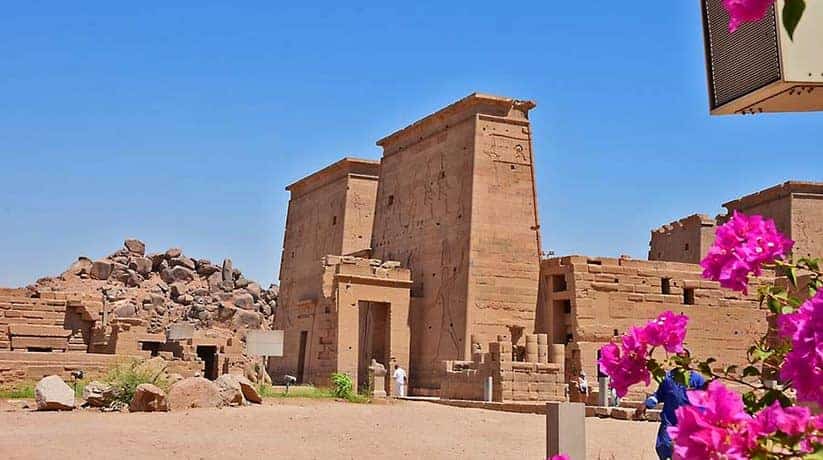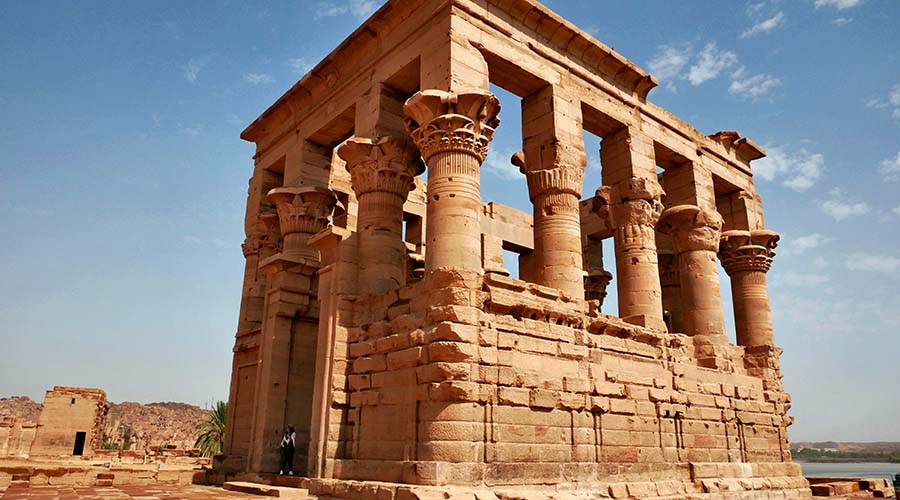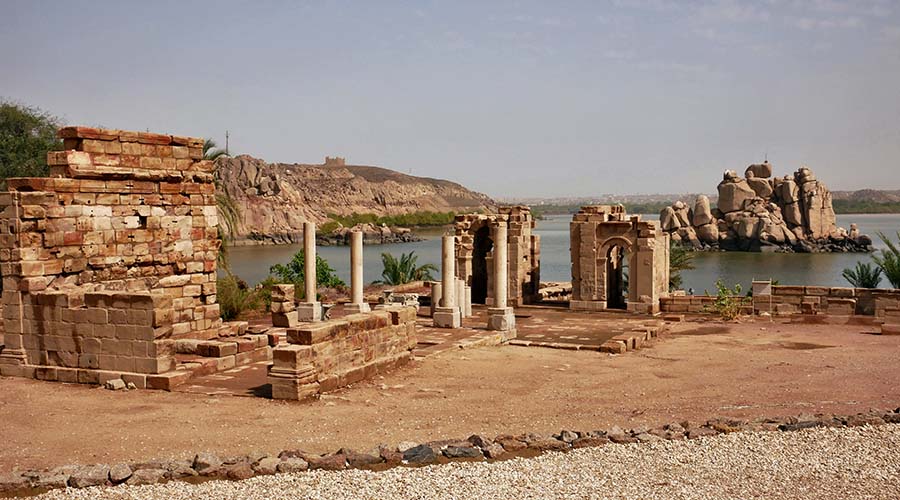Philae temple Aswan Egypt tours, prices, booking, reviews
Philae temple Aswan Egypt located 12 kilometers south of Aswan. In fact, the temple was an ancient pilgrimage center for the cult of Isis. It also was for the dazzled travelers with its power for centuries. In fact, the temple is sacred site and venerated from the Pharaonic era up to the Greek, Roman and Byzantine periods. In these periods, each ruler added his own stamp onto the stones here. The First Pylon at Philae temple Aswan, leads into the main temple area. In fact, the temple features two towers and central doorway. Both of them provide a grand 18 meter high entry. The entry with reliefs by Nectanebo. Moreover, there is a doorway in the western tower with reliefs by Philometor. It leads to the Birth House.
In front of the pylon two granite obelisks stand. In fact, they erected by Euergetes II. Moreover, there are also two granite lions. Adjoining the east tower, there is an elegant gateway. It has reliefs by Ptolemy II Philadelphus (on the lintel) and the Emperor Tiberius (on the jambs). The gateway which built by Philadelphus, stands in a brick wall. On the front of the east tower, a huge relief depicts Ptolemy XII Neos Dionysos. He grasps a band of enemies by the hair and raising his club to smite them.
Philae temple Aswan Egypt main Courtyard:
When you pass through the central doorway, look for the French inscription on the right. It shows commemorating Napoleon’s campaign and the pursuit of the Mamelukes. On either side of the Forecourt, you’ll see structures fronted by colonnades. The small building to the east contained rooms for the priests. In fact, the rooms served some scientific purpose. Philae temple Aswan features plant columns in its vestibule. They indeed are notable for their elegant proportions. On the north side of the building’s vestibule, there is a door. The door accesses the inner passage around the temple.
The building on the western side of the Forecourt is the Birth House (mammisi). In fact, it dedicated to Hathor-Isis in honor of the birth of her son Horus. It surrounded on all four sides by colonnades. The columns in which have foliage capitals surmounted by sistrum capitals. The walls, columns, and screens between the columns covered with reliefs. They also covered with and inscriptions by Euergetes II, Neos Dionysos, Augustus, and Tiberius. The Birth House features indeed interesting reliefs in the last chamber. The reliefs depict scenes from the childhood of Horus. They also include Horus as a falcon in the swamps of the Delta. Furthermore, they also include Isis suckles Horus in the swamps.
Philae temple Aswan Egypt Second Pylon:
The Second Pylon provides a regal entry to the inner sanctum of the temple. It is with a magnificent doorway 32 meters wide and 12 meters high. The reliefs on the central doorway are by Euergetes II. Moreover, in front of the doorway are the foundations of a small chapel. Within the central doorway are some much faded early Christian paintings. On the lower part of the doorway is a relief of a large figure of Neos Dionysos. In fact, it dedicates the slaughtered sacrificial animals to Horus and Hathor. On the right, the king depicted while he presents a garland to Horus and Nephthys. Moreover, on the left, he offers incense to Osiris, Isis, and Horus. It is while pouring water on the altar.
Philae temple Aswan Egypt Vestibule:
The eight-columned Vestibule is the first room of the inner temple area. In fact, it separated from the court by screens between the columns on the front. The walls has Coptic crosses and Greek inscription. They show how the temple transformed into a Christian place of worship. It was during the early Byzantine age under the Coptic Bishop Theodore. Above the door, there is another inscription. It commemorates the archaeological expedition sent to Philae in 1841 by Pope Gregory XVI. In fact, the Vestibule’s reliefs unfinished, but they indeed are still interesting. Over the door in the south wall, the top relief shows Horus sits on a bench with Nephthys and Isis. They present the crowns of Lower and Upper Egypt. The below reliefs depict the tomb of Osiris at Abaton, with the body of Osiris borne by a crocodile.
To the left of the door are unfinished reliefs. They shows the king while he makes grants of land. Above are three lines in Meroitic cursive script. On the right hand wall (second top row) is a famous relief. It depicts the source of the Nile, the god of the Nile with a snake. The snake entwined around his body and pours water from two jars. The jars are under a rocky crag on which perched a vulture and a falcon. To the right of this, the soul of Osiris in the form of a bird within the sacred grove. It worshiped by Hathor (left) and by Isis, Nephthys, Horus, and Amun (right).
Philae temple Aswan Sanctuary:
The antechambers which flanked by dark side chambers, lead to the Sanctuary. The sanctuary of Philae temple Aswan lit by two small windows. The granite base here presented by Euergetes I and his wife Berenice. It holds the sacred barque bearing the image of Isis. To the left of the first antechamber is a small room. In fact, the room has reliefs of the king in the presence of Isis. On the west side of this room is a door. In fact, the door leads out of the temple to arrive at the Gateway of Hadrian.
Philae temple Aswan EgyptGateway of Hadrian:
The small Gateway of Hadrian sits within the old enclosure wall of the temple. It is northwest of the Second Pylon. In fact, it built in the reign of the Emperor Hadrian. Furthermore, it decorated with reliefs by Hadrian, Marcus Aurelius, and Lucius Verus. The gateway presumably led to the Sanctuary of Abaton on the neighboring island of Bigga . There, there was a Tomb of Osiris and the reliefs relate to the cult of Osiris. On the lintel, Hadrian depicted while he makes offerings to Osiris, Isis and Harsiesis. On the left hand jamb is the sacred relic of Abydos. Furthermore, on the right hand jamb, the djed pillar of Osiris.
The ancient Egyptian name of Philae was Pilak, from which the Greek and Latin Philae derived. During the Islamic era, it known to the local people as El-Oasr which means the palace. The oldest surviving temple buildings here date back to the time of Nectanebo I (circa 370 BC). The principal deity worshiped was Isis. The imposing buildings that stand today erected by the Ptolemies in the last two centuries BC. They also erected by the Roman Emperors in the first three centuries AC. Many inscriptions show that pilgrims flocked to Philae in Greek and Roman times. It was to pay homage to the mysterious and benign Isis, goddess of healing.
Further details about Philae temple Aswan Gateway of Hadrian:
In fact, the Nubians remained faithful to the cult of Isis. It was long after introduction of Christianity. In the time of Justinian (527-565 AC) the temple closed. Some of its chambers converted for use in Christian worship. From then until the coming of Islam, a Coptic town flourished on the island. The island of Philae temple Aswan ranked as one of the most beautiful places in Egypt. Furthermore, it attracted large numbers of visitors every year. In fact, it was Until the construction of The Old Dam. Thereafter it was under water for the greater part of the year. The temple was accessible only between August and December. The construction of Egypt’s High Dam project threatened to engulf the temple for good. In fact, the temple saved from this fate between 1972 and 1980. It was through the great international rescue operation which sponsored by UNESCO.
The Temple of Hathor at Philae temple Aswan Egypt:
Just 50 meters east of the temple of Isis is the little temple of Hathor. In fact, it built by Philometor and Euergetes II in honor of Hathor-Aphrodite. The vestibule and the sanctuary (destroyed) of the temple added by Augustus. The best preserved part of the structure is the main temple chamber. It is on the front of which are two plant columns linked to the walls by screens. The columns of the Vestibule decorated with charming reliefs. The reliefs include flute-players and harpists, Bes with a tambourine. They also include Bes dance and play a harp , monkeys play the lyre, and priests bearing an antelope.
Kiosk of Trajan at Philae temple Aswan Egypt:
Nearby is the Kiosk of Trajan which indeed is the most distinctive of Philae’s monuments. Moreover, it is the focus of the second half of the Sound & Light Show. Reliefs inside the rectangular structure of 14 columns with screen walls. They depict the Emperor Trajan making offerings to Isis, Osiris and Horus. The roof is now no longer. The kiosk which was at one time the main entrance to the temple from the river, is airy and open. You can get a magnificent view of the kiosk from the river on the return journey from the island.
How to get to Philae temple Aswan:
The quay for motor boats to the Islands between the dams, is south of the Old Aswan Dam at Shallal. It reached by taxi from Aswan. The easiest way to visit Philae temple Aswan is as part of an organized trip. The organized trip often will not cost much more than going it alone. The ticket office for the temple is at the end of a tourist bazaar. It is at the gate to the boat landing. Tickets for the temple cost LE 120
















